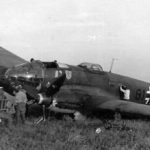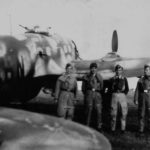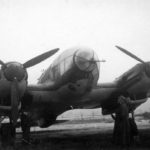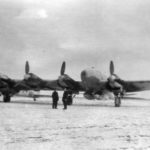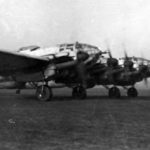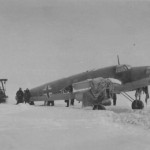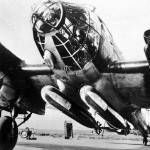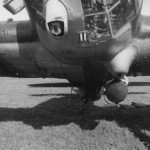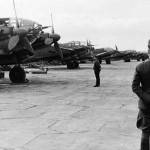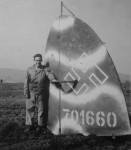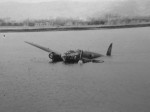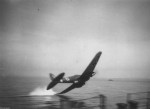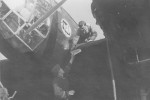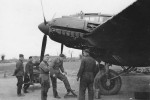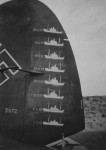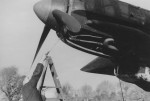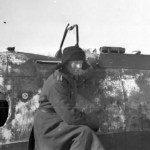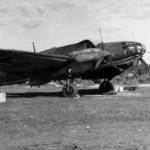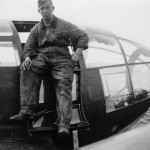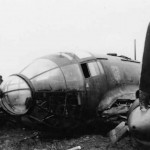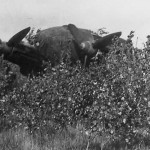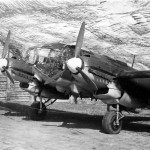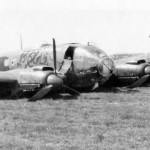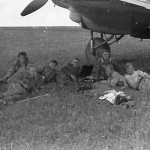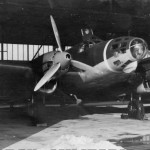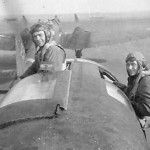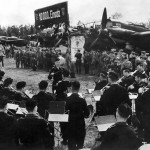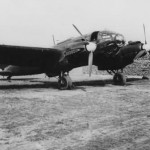Main landing gear of He111H from 5/KG 26, Vannes France 1940
German Luftwaffe medium bomber Heinkel He111 in flight
Heinkel He 111B-2 coded 25-46 from Legion Condor and bombs ready to load
Crashed Heinkel He 111 H G1+AD of the Stab III/KG 55 Samorsk Crimea 1944
He 111 H KGr 100 SC 250 bomb loading – Eastern Front 1941
Helmeted Luftwaffe Fallschirmjagers He111
Line of German Heinkel He 111of the KG26 on airfield in Italy 1941
Bomber Heinkel He 111 during Battle of Britain 1940
Bomber Heinkel He 111 B 25-15 of K/88 Legion Condor – Spain 1938
hangar full of wrecked Heinkel He 111 at Schmarbeck April 1945
Pilot and crew in cockpit of the He 111 during a combat mission
Luftwaffe crew and He111
Frontal view of a Heinkel He 111
Front view of a Heinkel He 111 Z
British He 111 “Delta Lily” of No. 260 Squadron RAF code HS-?, ex 5J -CR (III./KG4) North Africa
British Heinkel He 111 H AW177 ex 1H+EN of 5/KG 26 at RAF Duxford
Heinkel He 111 H of 8/KG 55 on a forward airfield in the Eastern Front, 1944
Damaged tail of He 111 W.Nr. 4469 code G1+FT of the KG 55 “Greif”
German Crew Hauling Bombs to He 111 of KG 54 Totenkopf 1940
Heinkel He 111 KG26 is loaded with a torpedoes
Heinkel He 111 of KG 26 “Löwengeschwader” in flight over Norway 1940
Early Heinkel He 111 J 74
German transport plane Heinkel He 111Z with Stammkennzeichen marking DG+DX
He111 Pedro 1 of the Legion Condor
Transport aircraft Heinkel He 111P coded CK+HC with tail code “P 4 6”, Italy 1943
group of soldiers next to a Heinkel He 111 H
Heinkel He 111 H of the KG 26 fitted with two torpedoes and ready for takeoff
Heinkel He 111 coded G1+ZR of the KG 55
Heinkel He 111 H-21,+DC, 1944-45
Heinkel He 111 Z in winter camouflage
He 111 P4+ of the Fuhrungskette X Fliegerkorps, North Africa
dual-fuselage Heinkel He 111 Z TM+ 1943
Heinkel He111 CQ VY
Heinkel He 111 GA
He 111 B-2 coded “25+57” from Legion Condor, Spain 1936
He111 coded V4+CP of the KG40 on a flooded airfield
Spain 1936: Heinkel He 111B coded 25-29 Legion Condor
Heinkel He111 7A+DH Aufklarungsgruppe 121
He111 H with the tactical code 3E+TZ of the 15/KG 6, Woroschilowgrad December 1942
He 111 H 1H+KN 5 KG 26 France Vannes 1940
White He111 from KG 55 coded G1+BH
He111 Kristiansand Norway 1940 1H+BH KG26
He111 B VB+BC Grosse Kampffliegerschule 3 Warsaw 1941
He 111 H with the tactical code A1+BT WNr 4566 of the 9/KG 53 is prepared for its next operation. Russia Winter 1942-43
He111 P with the tactical code 2F+LL of 3/KG 28 1939-40
He111 6N+NK 2/KGr 100 “Wiking” in Vannes France 1941
White He111 H coded A1+BM of the 4/KG 53, Russia winter 1942-43
Heinkel He 111 S3+FH TGr 30
He111 H 1H+AB Stab I.KG 26 Amsterdam Schiphol 1940
Heinkel He111 Bomber +JH
He111 6N+CK 2/KGr 100 in Vannes France 1941
He111 H A1+BT WNr 4566 9/KG 53 Russia Winter 42-43
German Bomber Heinkel He 111 of the Kampfgeschwader 26 with the tactical code 1H+FP
He111 H A1+BT WNr 4566 9/KG 53 Russia Winter 1942-43 2
Heinkel He 111 bombers with black camo on lower surfaces
Five-engine tow plane Heinkel He 111 Z “Zwilling” taxi before takeoff
Heinkel He 111 front view
Heinkel He 111 Z Zwilling rear view
Heinkel He 111P bomber with night camo (black undersurfaces)
Heinkel He 111 torpedo mounted under aircraft. Note large smoke stains from engines.
Front view of an Luftwaffe bomber Heinkel He 111 on ground
Heinkel He 111 H-8 “Ballonabweiser” cable cutter on the ground
Heinkel He 111H from II/KG26 Gabbert arfield, Pommern 1939
Heinkel He 111 of the KG27 is prepared for its next operation, Eastern Front
A winter camouflaged Heinkel He 111 of KG 27, Banak Norway
Heinkel He 111 B
A view inside the cockpit of a He 111 bomber with pilot, navigator and gunner
Ballonabweiser Heinkel He 111 H-8, cable cutter on the ground
Heinkel He 111 of Kampfgeschwader 54 Totenkopf
Heinkel He 111 Z Zwilling coded DG+DY (W.Nr. 2704)
Heinkel He 111 H-18 with FuG 200 Hohentwiel radar and torpedoes 1943
Heinkel He 111 bombers
Heinkel He 111 Tripoli Africa
He 111H from KG 26 at Flugplatz Gabbert, Saatzig Pommern, 4 September 1939
battleship Gneisenau and Heinkel He 111 North Sea 1939
He111 tail W Nr 701660
damaged He111
He111 H bomber
He 111 H-8 “Ballonabweiser” with balloon cable cutter device
He111 2/KGr 100 in Vannes France 1941 bomb bay
He111 P 2/KGr 100 “Wiking” in Vannes France im 1941
Heinkel He111 Medium Bomber at airfield
Crashed He111 in Russia, winter 1942-1943
He111 2/KGr 100 in Vannes France 1941
He111 2/KGr 100 in Vannes France 1941 night camo
Heinkel He111P bomber
The crew of a Heinkel He111H bomber, Eastern Front
Heinkel He111 of KG55
Heinkel He 111 crashed in Norway Stavanger
Crashed Heinkel He 111 B-2, coded 25-51 of Legion Condor 1936
Heinkel He111 Shot down during Battle of Britain 1940
He 111 of the 2/KGr 100 “Wiking” in Vannes France 1941 left side
Wreckage of German bomber He111 +AL, 1944/1945
He111 H from III/KG 26 fitted with two torpedoes ready for take off
Luftwaffe soldiers next to He111 bomber
Focke-Wulf Fw 200 of the KG40, tail gunner with camera
Heinkel He111 crashes into the sea
Damaged He111 with night camo Lille France
He111 with its landing gear broken at Mogilev, Eastern Front
Heinkel He111 Bombers at airfield
Heinkel He 111 Norway Stavanger
He 111 coded G1+KH of the KG55 on the ground
GIs posed by captured Luftwaffe bomber He111, 1944-1945
He111 march 1940
He111 2/KGr 100 in Vannes France 1941 landing gear
He 111 2/KGr 100 in Vannes France 1941 and crew
A heavy gantry crane is used in changing engine on a Heinkel He111
He 111 H of the 2/KGr 100 in Vannes France1941 left side
US Soldiers with Captured Luftwaffe He111 Bomber North Africa
He111 2/KGr 100 in Vannes France im 1941 cockpit
He111 Aalborg Denmark
He111 tail W Nr 3972
He111 of the Legion Condor, nose and cockpit side view
He111 of the 2/KGr 100 on the ground. Vannes France 1941
He111 H of II/KG 26 with SD 2500 KG Bomb
Cockpit of the Heinkel He 111 H/P
He111 2/KGr 100 in Vannes France 1941 right engine
Wreckage of Heinkel He111 of the KG26, Sola Norway 1940
Heinkel He 111 Luftwaffe bomber
Captured Heinkel He111H with black undersurfaces and flame concealing exhaust
Heinkel He 111 Luftwaffe bomber wreckage
Heinkel He 111being refuelled
Captured Heinkel He111 with flame concealing exhaust. 1945
GI in the cockpit of a destroyed Heinkel He111, Germany 1945
Heinkel He111 France 1940
Recovery of a Heinkel He111
Heinkel He 111 Luftwaffe bomber 3
Heinkel He 111 H-10
Heinkel He111 and bombs
Heinkel He111 ww2 bomber
Heinkel He111 Beauvais France
Heinkel He111 +HU on winter airfield
Heinkel He111 shot down in France 1940
Heinkel He111 right wing 1945
Ground crew of Legion Condor poses with aerial bombs. Heinkel He 111B in the background
Tail of the Heinkel He111 W.Nr. 8348, 1945
Recovery of a Heinkel He 111
Heinkel He 111 Luftwaffe bomber 5
Wreckage of German Heinkel He 111
Luftwaffe soldiers posing beside a crashed He 111
He111 VB+? – Banak Norway 1940
He 111 of the KG51 warming up its engines
Crew poses beside the Heinkel He111 +AM
He111 H of the 5/KG26 during Battle of Britain, Vannes France 1940
Heinkel He111 H warming up engines
Heinkel He111 winter 20
He111 KG55
Heinkel He111 bomber
Heinkel He111
He111 KG26 1940 Banak Norway 2
Heinkel He 111 luftwaffe bomber
Heinkel He111
Heinkel He111
Damaged Heinkel He111 14
A belly landed bomber Heinkel He 111
Heinkel He111 12
He 111 and Hauptmann Walter Nowotny from JG 54 October 1943
Heinkel He111
Heinkel He 111 B “Pedro 15” coded 25-15, of the K/88 Legion Condor, Spain
Crashed Heinkel He 111 25
Wreckage of a He 111 with camo spray pattern
Heinkel He111
Heinkel He 111 in winter
Crashed Heinkel He 111 27
He111 H-4 coded 1T+HK of the I/KG 28 rammed by soviet pilot.
He 111 at a captured Soviet airfield
He111 KG55 6
He111H of the KG55 during unit ceremony celebration
He111 KG55
Heinkel He 111 7
Heinkel He111 under camouflage netting
Luftwaffe mechanics at work on a He111 engines
Heinkel He 111’s bomb bay being loaded with bomb
Heinkel He111 winter 1940
Luftwaffe pilots Ar 96 and He 111 JG 107 Nancy Essay 1943
He111 Amiens 1940 3
Heinkel He 111 KG4 July 1941
Heinkel He111 Bombers
Heinkel He111, close up view
Bomber He111 with camouflage for night attacks over England
Heinkel He111 28
Heinkel He111 24
He111 KG55 7
Heinkel He111 22
He111E, this early variants had a conventional, stepped cockpit
He111 KG55
He111 october 1939
Crashed Heinkel He 111 Banak, Norway 1940-41
Heinkel He 111 of the KG100 with black undersurfaces
He111 of the Kampfgeschwader 55
Crew and He 111 of the KG55 9
He111 Amiens 1940 2
View of the wreckage of a He 111
Heinkel He 111
Ground crew overhauling a He111 Jumo 211 engines
He111 KG55 3
Heinkel He 111 planes on assembly line in factory
He111 tail section
Heinkel He 111 and luftwaffe crew
He111 of the KG55, mid-upper gunner
Heinkel He111 KG26 1940 Banak Norway
Heinkel Heinkel He111E
Heinkel He111 bomber
The cockpit interior of a bomber Heinkel He111E
KG 55 crew posing beside their Heinkel He111
Heinkel He111. Luftwaffe soldier sitting on a bomb
He111 KG26 1940 Banak Norway 3
Heinkel He111 Amiens 1940
Heinkel He 111E on the ground
The Heinkel He 111 was designed, ostensibly as a civil transport, in 1935, but in 1936 the He 111 B was delivered to the Luftwaffe and by the following year it had joined in the Spanish Civil War. Succeeding the He111 B series were the DB 600 powered He 111D and the Junkers Jumo 211 engined He 111E. The He 111 P (DB 601 engines) was the next major version, entering service some 6 months before the outbreak of the Second World War. The Heinkel He 111 P first introduced the asymmetrically placed bubble housing the nose machine gun that was a trade mark of all later He 111. Despite a wide variety of He 111 P sub-types, production of this series was not extensive, and in 1939 it began to be superseded by the more promising Junkers Jumo powered Heinkel He 111 H.
Like the Ju87 Stuka, the He 111 performed extremely well in the opening phase of Second World War, but was recognized as terribly inadequate during the Battle of Britain. By mid–1940, the He 111 still formed the backbone of the Luftwaffe, but it was evident that it had become obsolete. Indeed the fast aircraft of 1937 had become a lumbering, poorly armed bomber, extremely vulnerable to modern fighters. In response Heinkel added extra machine guns and armor, and tried to
improve both altitude and speed, but to no avail. Coupled with incessant growth in equipment and armor, the result was only further deteriorating performance. The short-sightedness of the RLM was shown by the fact that they made no use of available replacements. Instead the obsolete and waddling He111 was built in ever greater number until 1944, as it was easy to manufacture, economical in manpower and material, could absorb a great deal of enemy fire, and remained
reasonably effective on the less demanding Eastern front. The Heinkel He111 served on all fronts as medium bomber, but from mid–1943 its role was less important. It remained in service and was used for more specialized missions, including as torpedo bomber, barrage-balloon cable-cutter, glider tug, magnetic-mine exploder, V1 missile carrier, and transport plane. Undoubtedly the most spectacular conversion was the special He 111 Z (Zwilling — twin), designed in 1942 for the purpose of towing the giant Me 321 glider; this consisted of two He 111s joined by a common center wing carrying a fifth engine. Spanish CASA continued production after World War II until 1956 (model CASA 2.111).
Production: 6508 aircrafts.
General Description
- Type: Twin-engined bomber and torpedo-carrier, also adaptable as a transport, glider-tug, or flying-bomb carrier.
Wings
- Configuration: Low-wing cantilever monoplane with three parts: a rectangular center-section integral with the fuselage and two tapering outer sections.
- Structure:
- Made of light metal with two spars and multiple ribs.
- Covered with a stressed skin of smooth duralumin sheet.
- Ailerons are located on the outer sections, with hydraulically-operated slotted flaps on the inner sections. Ailerons droop with flap deployment.
Fuselage
- Shape: Oval-section, tapering to a point aft.
- Construction:
- Made of metal with three main bulkheads and several secondary frames.
- Interconnected by longerons and ‘U’ section stringers.
- Covered with smooth metal sheet.
Tail Unit
- Type: Monoplane with elliptical surfaces.
- Structure: Cantilever tailplane and fin, all-metal structure with smooth sheet covering.
- Control Surfaces: Includes trimming-tabs in the movable surfaces.
Landing Gear
- Type: Retractable.
- Mechanism: Comprises two oleo legs and two backwardly sloping hinged members, retracting the wheels aft into the engine nacelles. Equipped with low-pressure wheels and Cannstadt brakes.
Power Plant
- Engines: Two Junkers Jumo 211F twelve-cylinder inverted Vee liquid-cooled engines, each rated at 1,300 hp at 3,810 m (12,500 ft).
- Propellers: Three-bladed VDM controllable-pitch full-feathering airscrews.
- Fuel Capacity: Four self-sealing fuel tanks (two inboard and two outboard of nacelles) with a total capacity of 940 Imperial gallons.
Accommodation
- Crew: Five members.
- Layout:
- Pilot on the port side in an asymmetrical, fully glazed nose compartment.
- Navigator/bomb-aimer alongside the pilot with a tip-up seat, also operating a machine-gun in the nose.
- Bomb compartment behind the pilot between wing spars.
- Passageway leading to aft cabin, where the radio-operator/gunner operates the upper gun and another gunner manages the lower gun.
- Pilot’s seat and gun positions are armored.
Armament
- Configurations:
- Includes variations such as one 13 mm MG 131 in the nose, two 7.9 mm MG 81 in the lower ventral position, one 13 mm MG 131 in the upper rear-firing position, and two 7.9 mm MG 81 on each side of the fuselage.
- Bomb Load:
- Initial internal storage for up to eight 250 kg bombs.
- Later modifications allowed external stowage for larger bombs, mines, torpedoes, or one FZG 76 flying-bomb.
- Various load configurations include combinations of 1,000 kg, 1,400 kg, 1,800 kg, and 2,500 kg bombs.
- Can carry two torpedoes under the center-section roots.
Equipment
- Radio: Standard bomber radio equipment, including long and short wave transmitting and receiving sets, D/F loop receiver, and blind-approach equipment.
- Navigation: Equipped with a Lorenz blind-approach system and an inflatable dinghy.
Specifications:
variant | He111 V1 | He111 A-0 | He111 B-2 | He111 D-0 |
crew | 4 | 4 | 4 | 4 |
wingspan (m) | 25,00 | 22,61 | 22,61 | 22,61 |
lenght (m) | 17,38 | 17,50 | 17,51 | 17,51 |
height (m) | 4,10 | 4,10 | 4,20 | 4,20 |
wing area (m2) | 87,60 | 86,50 | 86,50 | |
gross weight (kg) | 5782 | 5400 | 5800 | 6000 |
normal take-off weight (kg) | 7590 | 8209 | 8600 | 8800 |
bombs (kg) | 500 – 1000 | 1500 | 1500 | |
engines | BMW VI 6,0 Z, 650 hp | BMW VI 6,0 Z, 650 hp | Daimler-Benz DB 600 CG, 936 hp | Daimler-Benz DB 600 Ga, 1036 hp |
max speed (km/h) | 309 (at 5400 m) | 370 at 4000 m | 410 at 4000 m | |
cruising speed (km/h) | 270 | 344 | 370 | |
landing speed (km/h) | 110 | 115 | 120 | |
service ceiling (m) | 6000 | 6000 | 7000 | 7000 |
range (km) | 1500 | 1000 – 2500 | 1065 | 1065 |
armament | 3 x MG15 7,9 mm | 3 x MG15 7,9 mm | 3 x MG15 7,9 mm |
variant | He111 E-1 | He111 F-1 | He111 J-1 | He111 P-1 |
crew | 4 | 4 | 4 | 4 |
wingspan (m) | 22,50 | 22,50 | 22,50 | 22,60 |
lenght (m) | 17,50 | 17,51 | 17,51 | 16,40 |
height (m) | 4,20 | 4,20 | 4,20 | 4,00 |
wing area (m2) | 86,50 | 86,50 | 86,50 | 87,60 |
gross weight (kg) | 6135 | 6200 | 6120 | |
normal take-off weight (kg) | 10600 | 10600 | 10550 | 13300 |
bombs (kg) | 2000 | 2000 | 2000 or 2 torpedo | 2000 |
engines | Junkers Jumo 211 A-1, 986 hp | Junkers Jumo 211 A-3, 1084 hp | Daimler-Benz DB 600 Ga, 1036 hp | Daimler-Benz DB 601 Aa, 1134 hp |
max speed (km/h) | 430 | 440 | 415 at 5000 m | |
cruising speed (km/h) | 380 | 385 | 370 | |
landing speed (km/h) | 120 | 120 | 120 | |
service ceiling (m) | 6000 | 6000 | 7000 | |
range (km) | 1820 | 1820 | 1820 | |
armament | 3 x MG15 7,9 mm | 3 x MG15 7,9 mm | 3 x MG15 7,9 mm | 3 x MG15 7,9 mm |
variant | He111 P-2 | He111 P-4 | He111 P-5 | He111 P-6 |
crew | 4 | 5 | 5 | |
wingspan (m) | 22,60 | 22,60 | 22,60 | 22,60 |
lenght (m) | 16,40 | 16,40 | 16,40 | 16,40 |
height (m) | 4,00 | 4,00 | 4,00 | 4,00 |
wing area (m2) | 87,60 | 87,60 | 87,60 | 87,60 |
gross weight (kg) | 6020 | 6775 | ||
normal take-off weight (kg) | 12570 | 13500 | 13820 | 14000 |
bombs (kg) | 1500 – 2000 | 2000 – 2500 | 2000 | |
engines | Daimler-Benz DB 601 Aa, 1134 hp | Daimler-Benz DB 601 A-1, 1084 hp | Daimler-Benz DB 601 A-1, 1084 hp | Daimler-Benz DB 601 N, 1183 hp |
max speed (km/h) | 410 at 5000m | 398 at 5000m | 380 | 425 |
cruising speed (km/h) | 380 | 370 | ||
landing speed (km/h) | 120 | 120 | ||
service ceiling (m) | 7800 | 8000 | ||
range (km) | 1970 – 2100 | 2450 | ||
armament | 4-5 x MG15 7,9 mm | 6 x MG15 + MG17 | 3 x MG15 7,9 mm |
variant | He111 H-1 | He111 H-3 | He111 H-4 | He111 H-5 |
crew | 4 | 4 | 5 | 5 |
wingspan (m) | 22,60 | 22,60 | 22,60 | 22,60 |
lenght (m) | 16,40 | 16,40 | 16,40 | 16,40 |
height (m) | 4,00 | 4,00 | 4,00 | 4,00 |
wing area (m2) | 87,60 | 87,60 | 87,60 | 87,60 |
gross weight (kg) | 6740 | 7200 | 6850 | 6950 |
normal take-off weight (kg) | 12600 | 13120 | 14220 | 15700 |
bombs (kg) | 2000 | 2000 | 1500 | 2500 |
engines | Junkers JUMO 211 A-1, 986 hp | Junkers JUMO 211 D-1, 1183 hp | Junkers JUMO 211 D-1 or F-a, 1300 hp | Junkers JUMO 211 F-1, 1300 hp |
max speed (km/h) | 410 at 6000m | 440 | 425 at 6000m | 405 at 6000m |
cruising speed (km/h) | 370 | 375 | 330 | 330 |
landing speed (km/h) | 125 | 125 | 125 | 125 |
service ceiling (m) | 8000 | 8000 | 8500 | 8500 |
range (km) | 2060 | 2060 | 2600 | 3100 |
armament | 3 x MG15 7,9 mm | 7 x MG15 | 6 x MG15 | 6 x MG15 |
variant | He111 H-6 | He111 H-16 | He111 H-20 | He111 H-21 |
crew | 5 | 3-4 | ||
wingspan (m) | 22,60 | 22,60 | 22,60 | 22,60 |
lenght (m) | 16,40 | 16,40 | 16,40 | 16,40 |
height (m) | 4,00 | 4,00 | 4,00 | 4,00 |
wing area (m2) | 87,60 | 87,60 | 87,60 | 87,60 |
gross weight (kg) | 8680 | 6900 | 8680 | 7050 |
normal take-off weight (kg) | 14000 | 14000 | 14000 | 14000 |
bombs (kg) | 2000 or 2 x torpedo | 2000 | 3000 | |
engines | Junkers JUMO 211 F-1 or F-2, 1321 hp | Junkers JUMO 211 F-2, 1321 hp | Junkers JUMO 211 F-2, 1321 hp | Junkers JUMO 213 E-1, 1751 hp |
max speed (km/h) | 440 | 434 at 6000m | 440 | 480 at 7000m |
cruising speed (km/h) | 330 | 390 | 330 | 410 |
landing speed (km/h) | 135 | 135 | 125 | 140 |
service ceiling (m) | 8500 | 8500 | 8500 | 10000 |
range (km) | 2060 | 2060 | 2250 | 2060 |
armament | 6 x MG15, MG17, MG-FF | 5 x MG15, MG17, MG-FF | 3 x MG131, 2 x MG 81Z | 3 x MG131, 2 x MG 81Z, 1×20 mm |
variant | He111 H-22 | He111 H-23 | He111 R-2 | He111 Z-1 Zwilling |
crew | 5 | 7-9 | ||
wingspan (m) | 22,60 | 22,60 | 22,60 | 35,20 |
lenght (m) | 16,40 | 16,40 | 16,40 | 16,69 |
height (m) | 4,00 | 4,00 | 4,00 | 4,53 |
wing area (m2) | 87,60 | 87,60 | 87,60 | 147,44 |
gross weight (kg) | 10500 | 6800 | 6800 | 14970 |
normal take-off weight (kg) | 15930 | 13200 | 13000 | 29700 |
bombs (kg) | 3000 or V-1 | 1000 | 2000 | – |
engines | Junkers JUMO 213 E-1, 1751 hp | Junkers JUMO 213 A-1, 1775 hp | Daimler-Benz DB 603 U, 1715 hp | 5 x Junkers JUMO 211 F-2, 1321 hp |
max speed (km/h) | 475 | 490 at 7000m | 500 at 9000m | 437 at 6000m |
cruising speed (km/h) | 370 | 410 | 470 | 394 |
landing speed (km/h) | 140 | 140 | 135 | |
service ceiling (m) | 10000 | 10000 | 13000 | 10200 |
range (km) | 2900 | 2060 | 1800 | 4000 |
armament | 2 x MG131, 1 x MG 81Z | 2 x MG131, 4 x 7,9 mm | 6 x 7,9mm, 1×20 mm | 6 x 7,9mm,1×13 mm, 1×20 mm |
Bibliography
- Shigeru Nohara, Masato Tanaka – Heinkel He111, Aero Detail 18
- Christopher F. Shores: Luftwaffe Bomber Camouflage & Markings 1940 – Heinkel He111 – Junkers Ju88 – Dornier Do17, Aircam Aviation Series 10
- Horst Scheibert: Heinkel He111, Waffen-Arsenal 20
- Manfred Griehl: German Bombers Over England, 1940-44 (Luftwaffe At War)
- Andy Saunders: Arrival of Eagles: Luftwaffe Landings in Britain 1939-1945
- John Weal: He 111 Kampfgeschwader in the West – Osprey Combat Aircraft 91
- Ron Mackay: Heinkel He 111, Crowood Press 2003
- George Punka – Heinkel He 111 in Action, Squadron/Signal Publications Aircraft Number 184
- John Weal: He 111 Kampfgeschwader on the Russian Front – Osprey Combat Aircraft 100
- Krzysztof Janowicz: Heinkel He 111 Vol.I – Kagero Monographs 3 (Polish/English)
- Krzysztof Janowicz: Heinkel He 111 Vol.II – Kagero Monographs 8 (Polish/English)
- Manfred Griehl: Heinkel He 111 Part 1: The Early Variants A – G and J of the standard bomber aircraft of the Luftwaffe in World War II (World War II Combat Aircraft Photo Archive 004), AirDoc
- Manfred Griehl: Heinkel He 111 Part 2: P and Early H variants of the Standard Bomber Aircraft of the Luftwaffe in World War II (World War II Combat Aircraft Photo Archive 007), AirDoc
- Manfred Griehl: Heinkel He 111 Part 3: The Late Variants H-6 to H-20 and Z (World War II Combat Aircraft Photo Archive 010), AirDoc
- Franz Kober: He 111 an allen Fronten vom ersten bis zum letzten Tag, Podzun-Pallas-Verlag Waffen-Arsenal Band 50
- Philip Moyes – Heinkel He 111 P & H, Aerodata International No.12, Vintage Aviation Publications 1979
- H Regnat: Vom Original zum Modell Heinkel He 111, Bernard & Graefe Verlag 2000
- Flugzeug Profile 18: Heinkel He 111 H Varianten
- Karl Ries, Hans Ring – Legion Condor, 1936-1939: Eine illustrierte Dokumentation
- Richard Smith & Eddie J Creek – Kampfflieger Volume 2: Bombers of the Luftwaffe July 1940 – December 1941 (Luftwaffe Colours),
- Classic Publications 2005
- Richard Smith & Eddie J Creek – Kampfflieger- Bombers of the Luftwaffe 1933-1940, Volume 1 (Luftwaffe Colours),
- Classic Publications 2004,
- Dr Alfred Price – Kampfflieger Volume 3: Bombers of the Luftwaffe January 1942 – September 1943 (Luftwaffe Colours),
- Classic Publications 2005
- Nick Beale – Kampfflieger Volume 4: Bombers of the Luftwaffe Summer 1943 – May 1945 (Luftwaffe Colours),
- Classic Publications 2005
- Robert Stedman, Kampfflieger: Bomber Crewman of the Luftwaffe 1939-45
- Georg Brütting: Das waren die deutschen Kampfflieger-Asse 1939-1945 (german)
- Alain Fleuret: Luftwaffe Camouflage, 1935-40; Kookaburra Technical Publications 1981
- Chris McNab: Hitler’s Eagles The Luftwaffe 1933-45
- Christopher Ailsby: Luftwaffe: A Pictorial History of the German Air Force of WWII
- Joachim Dressel, Manfred Griehl, M.J. Shields – The Luftwaffe Album: Fighters and Bombers of the German Air Force 1933-1945,
- Brockhampton Press 1999
- Brian L. Davis and Ursula J. Lazard: Luftwaffe Air Crews, Battle Of Britain 1940
- Mike Spick – Luftwaffe Bomber Aces: Men, Machines, Methods
- Manfred Griehl: German Elite Pathfinders KG 100 in Action (Luftwaffe At War)
- Lt Col John J. Jacobson – Schwerpunkt: The Luftwaffe And The Applied Air Campaign In Europe 1943-1944
- Alfred Price – The Luftwaffe in Camera 1939-1945
- Williamson Murray – Strategy for Defeat: The Luftwaffe, 1933-1945
- Manfred Griehl: German Bombers over Russia, Luftwaffe at War 15 Greenhill Books 2000
- Andy Saunders: Luftwaffe Bombers in the Blitz 1940-1941 (Images of War)
- Andy Saunders: Luftwaffe Bombers in the Battle of Britain (Images of War)
- Peter J. C. Smith – Air-Launched Doodlebugs: The Forgotten Campaign
- Frank Joseph – The Axis Air Forces: Flying in Support of the German Luftwaffe
- Philip Kaplan: The Battle of Britain: Luftwaffe Blitz: Rare photographs from Wartime Archives (Images of War)
- Wolfgang Dierich: Kampfgeschwader “Edelweiss”. The History of a German Bomber Unit 1939-1945 – Littlehampton Book Services Ltd 1975
- Wolfgang Dierich: Kampfgeschwader 55 “Greif”: Eine Chronik aus Dokumenten and Berichten 1937-1945 – Motorbuch Verlag 1975 (german)
- Brian Philpott – German bombers over Russia, World War 2 Photo Album Number 8
- German Bombers of WWII – Aviation Archive
- Jerry Scutts – Luftwaffe Bomber Units 1939-41, Osprey Publishing Airwar 15
- Jean-Denis G. G. Lepage: Aircraft of the Luftwaffe, 1935-1945 An Illustrated Guide
- Kalevi Keskinen, Kari Stenman: Saksalaiset Koneet Suomessa 1939 – 1945 / German Aircraft in Finland 1939 – 1945, Suomen Ilmavoimien Historia 16, 1998
- Aufklarer: Luftwaffe Reconnaissance Aircraft & Units 1935-1945 – Hikoki Publications 1997
- Aufklarer Volume 2: Luftwaffe Reconnaisance Aircraft and Units 1942-1945 (Luftwaffe Colours), Classic Publications 2008
- Aufklarer Volume 1: Luftwaffe Reconnaisance Aircraft and Units 1935-1941 (Luftwaffe Colours), Classic Publications 2007
- Heinkel: Chronik und Typenblatter der Firma Heinkel-Flugzeugbau, Aviatic Verlag GmbH 1989
- Manfred Griehl: Heinkel Combat Aircraft, Arms & Armour Press 1992
- Peter W. Cohausz – Deutsche Flugzeugcockpits und Instrumentenbretter Teil 6. Zweiter Weltkrieg Heinkel – Junkers, Cockpit Profile 6



